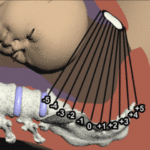Seven Cardinal Movements in Labor Transcript
Seven Cardinal Movements in Labor
This is Dr. Cal Shipley with a review of the seven cardinal movements in labor. The cardinal movements in labor are so named because they are considered essential to successful navigation by the fetus of the maternal birth canal. To better understand the significance of the cardinal movements, let’s do a brief review of maternal pelvic anatomy.
Maternal Pelvic Anatomy
Viewing the fetus and the maternal pelvis in a cross-sectional view from the mother’s right side, the front (also known as the anterior) border of the birth canal is provided by the mother’s pubic bone. While the lowest part of the mother’s spine, the sacrum makes up the back (posterior) wall. The pelvic inlet is described by a line going from the top of the pubic bone to the top of the sacrum.
The pelvic outlet is described by a line going from the bottom of the pubic bone to the tip of the sacrum. The fetus enters the birth canal at the pelvic inlet and exits through the pelvic outlet.
Pelvic Inlet versus Pelvic Outlet
In relation to how the cardinal movements facilitate passage of the fetus through the birth canal, it is important to note one key anatomical difference between the pelvic inlet and the pelvic outlet. Viewing the pelvis from above, the yellow line highlights the outer border of the pelvic inlet. The long axis of the pelvic inlet goes from left to right. In other words, the pelvic inlet is wider than it is deep.
Changing our view to the bottom of the pelvis, we can see that the situation for the pelvic outlet is the opposite of that of the inlet. The long axis goes from the front to the back, the pelvic outlet is deeper than it is wide. The orientation of the long axis of the pelvic inlet and pelvic outlet will come into play when we examine the cardinal movements later in the presentation.
Fetal Stations during Labor
In order to chart the position of the fetus as it moves through the birth canal, a system of fetal stations was devised many years ago and is still in use today.
There are some variations, but the most commonly used fetal station system today assigns a value of -5 to the pelvic inlet and a value of +5 to the pelvic outlet.
Ischial Spines
Located approximately halfway between the pelvic inlet and the pelvic outlet are the ischial spines of the maternal pelvis. The ischial spines are difficult to depict on a cross-sectional side view. Let’s switch to a frontal view to clarify their anatomical position.
Rotating to a view from above the pelvis gives us an even better look. The significance of the ischial spines is that they represent the narrowest part of the birth canal, and therefore, the most difficult portion of the canal for the fetal head and shoulders to traverse. The ischial spines are assigned a fetal station value of zero. In between, -5, 0, and +5, fetal stations are assigned sequential values as shown here. Each of these fetal station values represents the number of centimeters above or below the level of the ischial spines. For example, the -3 station is considered to be approximately 3 centimeters above the level of the ischial spines at zero station. Whereas +5, at the pelvic outlet, is considered to be approximately 5 centimeters below the level of the ischial spines at zero station.
Pelvic Curvature
Another key aspect of birth canal anatomy is the fact that a path traced from the inlet to the outlet has a significant curvature. In addition to the narrowing of the pelvis at the ischial spines, the curvature of the birth canal makes successful movement of the fetus through it a difficult proposition.
Cardinal Movements
Let’s see how the cardinal movements assist the fetus in accomplishing this task.
First Cardinal Movement
The first of the cardinal movements is descent. Although technically, the fetus is descending the entire time it is moving through the birth canal, Descent, as a cardinal movement, is usually defined as the point at which the fetal head moves into the pelvis through the pelvic inlet at -5 station and descends toward the ischial spines.
Second Cardinal Movement
The second cardinal movement is engagement. Engagement occurs when the fetal head has reached the ischial spines at zero station. At any fetal station with a negative value, the fetal head is said to be floating, but once it reaches zero station, the fetal head is said to be engaged.
Before we move on, it’s important to note that in many pregnant women, the fetal head has descended through the pelvic inlet in the days or weeks prior to the onset of labor. Likewise, in a minority of pregnant women, the fetal head may also be engaged prior to labor.
Third Cardinal Movement
The third cardinal movement is flexion of the fetal head. The fetal head flexes as it accommodates to the curvature of the sacrum.
Fourth Cardinal Movement
The fourth cardinal movement is internal rotation of the fetal head. This rotation of the fetal head is termed internal because it occurs within the birth canal. Internal rotation of the fetal head orients the long axis of the fetal skull with the long axis of the pelvic outlet, thus facilitating passage of the fetal head through the outlet.
To make this a little easier to see, recall our view from below of the pelvic outlet from earlier in the presentation. Recall also that the long axis of the outlet runs from front to back. Prior to internal rotation, the long axis of the fetal head is lying in more of a transverse left-to-right position. In this orientation, the long axis of the fetal head may exceed the width of the pelvic outlet, making delivery of the head very difficult. However, once internal rotation has taken place, the long axis of the fetal head and the pelvic outlet match, making delivery of the head much less of a challenge.
Shoulder Rotation
The internal rotation of the fetal head is followed by rotation of the shoulders. Shoulder rotation is not generally listed independently as a cardinal movement because it is connected to the internal rotation of the fetal head. As the fetal head rotates, rotational force is transmitted to the lower body. As a result, the fetal shoulders have a natural tendency to rotate as they enter the birth canal. Once the shoulders have rotated, their long axis now matches the long axis of the pelvic inlet.
Fifth Cardinal Movement
The fifth cardinal movement is extension of the fetal head. Extension of the fetal head facilitates its movement beneath the mother’s pubic bone and allows delivery of the head.
Sixth and Seventh Cardinal Movement
The sixth cardinal movement is external rotation of the baby’s head. This movement is also known as restitution. Once the fetal head delivers and becomes free of the constraints of the pelvis, it rotates slightly to assume its natural alignment relative to the shoulders. External rotation of the head is typically associated with delivery of the anterior shoulder, which allows for completion of the delivery.
The medical term for completion of the delivery is expulsion, and expulsion is the seventh and final cardinal–
Cal Shipley, M.D. copyright 2023

